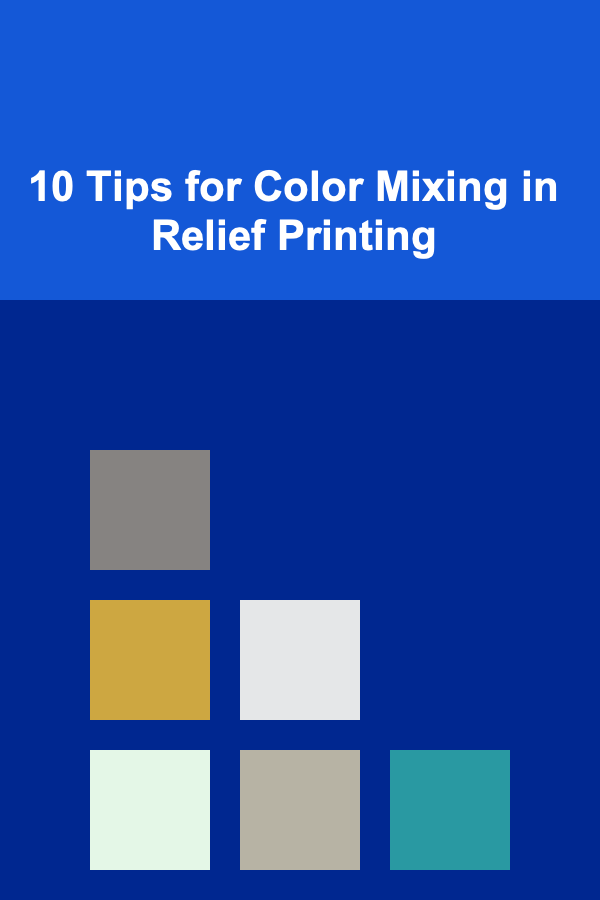
10 Tips for Color Mixing in Relief Printing
ebook include PDF & Audio bundle (Micro Guide)
$12.99$8.99
Limited Time Offer! Order within the next:

Color mixing in relief printing is both an art and a science. Whether you are a seasoned printmaker or a newcomer exploring the tactile and visual possibilities of relief techniques, mastering color mixing can elevate your work to new levels of depth, emotion, and vibrancy. Unlike digital or painting mediums, relief printing requires thoughtful preparation because colors are often applied with limited layering possibilities and the inks behave differently on the block and paper surfaces.
This article dives deep into ten essential tips for color mixing in relief printing, covering practical techniques, color theory considerations, ink behavior, and creative experimentation. By understanding and applying these principles, you can unlock more nuanced, balanced, and compelling color effects in your prints.
Understand the Nature of Relief Printing Inks
The foundation of successful color mixing begins with understanding the materials you are working with. Relief printing typically uses oil-based or water-based inks, each with its own characteristics that influence how colors mix and print.
- Viscosity and Consistency: Relief inks are generally thicker than paints, so their viscosity affects how well colors blend when mixed. Oil-based inks tend to be thicker and dry slower, allowing more working time for blending, while water-based inks dry faster and may require quicker mixing.
- Transparency and Opacity: Most relief printing inks are somewhat opaque, meaning they cover underlying colors rather than allowing them to shine through. This opacity can limit traditional glazing techniques common in painting but offers strong, bold color effects.
- Drying Properties: Oil-based inks dry by oxidation and polymerization, which is slower, allowing longer manipulation. Water-based inks dry by evaporation, leading to quicker setting on the printing surface.
Knowing these properties helps you predict how your colors will behave when mixed on the palette or printed on paper.
Master the Basics of Color Theory for Relief Printing
A solid grasp of color theory is essential for intentional and harmonious color mixing. Relief printing, because of its layering and limited blending opportunities, demands precise color planning.
- Primary Colors: Use cyan, magenta, and yellow (CMY) as your primary colors rather than traditional red, blue, and yellow. CMY primaries offer a broader gamut and cleaner color mixing in printing.
- Subtractive Color Mixing: Printing inks use subtractive color mixing, where colors absorb (subtract) certain wavelengths of light. Mixing cyan and yellow yields green, magenta and yellow yield red, cyan and magenta yield blue, and all three create a muddy black.
- Complementary Colors: Mixing complementary colors (colors opposite on the color wheel) can neutralize or tone down hues, useful for creating muted tones or shadows.
- Value and Saturation: Consider the lightness/darkness (value) and intensity (saturation) of your colors. Relief printing inks can be diluted with transparent base or extender to adjust these qualities without losing printability.
Understanding how inks interact subtractively and the role of value/saturation ensures your mixed colors translate well in the final print.
Use a Transparent Extender to Modify Ink Properties
Transparent extenders (sometimes called reducers or modifiers) are essential tools for color mixing in relief printing, allowing you to:
- Lighten Colors Without Changing Hue: Adding a transparent extender reduces the pigment concentration, lightening the color while maintaining its hue, unlike adding white ink which can make colors chalky or opaque.
- Increase Ink Transparency: Extenders increase transparency, enabling subtle layering effects and color interactions when printing multiple layers.
- Adjust Consistency and Drying Time: Extenders can thin inks to make them easier to roll out and spread evenly on the block, and also influence drying speed.
Using a transparent extender gives you fine control over the ink's visual and physical characteristics, crucial for nuanced color mixing.
Test Your Color Mixes on Scrap Paper Before Printing
One of the most overlooked but critical practices in relief printing is testing your ink mixes before applying them to your block. Because the ink's appearance changes from palette to block to paper, a test patch is invaluable.
- Create Small Test Swatches: Mix a small batch of ink and print a test patch on the type of paper you will use for your final print.
- Observe Under Print Conditions: Look at how the color appears under your printing press conditions---pressure, paper texture, and drying environment all affect color perception.
- Keep Detailed Records: Note proportions, brand, and type of inks used in each test. Over time, this "color diary" helps refine your intuition and repeatability.
Testing ensures you won't be surprised by unexpected color shifts or opacity changes in your final print.
Mix Colors on a Flat, Non-Absorbent Surface
The surface on which you mix inks can significantly impact your ability to achieve smooth, consistent color blends.
- Use Plexiglass or Glass Palettes: These non-porous surfaces allow inks to sit on top without absorbing or drying out too quickly.
- Avoid Paper or Wood Palettes: These surfaces absorb ink oils and moisture, altering consistency and drying behavior.
- Clean Palette Between Mixes: Residual ink can contaminate new colors, so thoroughly clean the palette between mixes for pure, predictable hues.
A flat, non-absorbent palette lets you visually assess the true color and consistency of your ink mixtures.
Employ a Palette Knife or Ink Roller for Thorough Mixing
Proper mixing tools ensure your colors are blended evenly and consistently, avoiding streaks or patches of unmixed pigment.
- Palette Knife: Use a sturdy palette knife to fold and blend inks thoroughly. Apply pressure and spread the mixture to combine pigments completely.
- Ink Roller (Brayer): Rolling inks together on the palette with a brayer ensures an even, smooth blend and prevents air bubbles.
- Avoid Overmixing: Excessive mixing can introduce air bubbles or warm the ink excessively, which may alter drying time.
Using the right tools helps maintain ink integrity while achieving the desired color mix.
Experiment with Layering Transparent Colors
Although relief printing traditionally relies on solid colors, layering semi-transparent inks can produce complex, luminous color effects.
- Print Light to Dark: Apply lighter transparent colors first, then layer darker tones on top to build depth.
- Use Transparent Extenders: As noted, extenders increase transparency and allow for glazing-like effects.
- Registration Precision: Achieving perfect registration (alignment) between layers is crucial to avoid muddy colors or unintended overlaps.
- Plan Color Interaction: Be mindful of subtractive color mixing---layering cyan over yellow produces green, but layering too many colors may dull the image.
Layering transparent colors can simulate painterly effects and add dimensionality to your prints beyond flat color blocks.
Balance Warm and Cool Colors for Visual Harmony
Mixing colors isn't just about the mechanical blending of pigments; it's about creating visual harmony and emotional resonance.
- Understand Temperature Shifts: Warm colors (reds, oranges, yellows) can advance toward the viewer, while cool colors (blues, greens, purples) recede. Use this to create spatial depth.
- Use Warm and Cool Variants: A warm red (like cadmium red) behaves differently than a cool red (like alizarin crimson). Mixing warm and cool versions of a color can soften or intensify your palette.
- Create Contrast and Balance: Use complementary warm-cool color pairs to energize compositions and draw attention.
A balanced warm-cool color scheme keeps your prints visually engaging and dynamic.
Anticipate Color Shifts Due to Paper and Ink Interactions
The final appearance of your printed color depends heavily on the paper used and how inks interact with it.
- Paper Texture and Color: Rough or absorbent papers will mute colors more than smooth, coated papers. White papers make colors pop, while off-white or toned papers warm or cool the overall palette.
- Ink Absorption and Spread: Some papers absorb ink more, causing colors to appear less saturated or darker.
- Press Pressure and Ink Transfer: Heavier pressure can flatten ink layers, affecting transparency and brightness.
Test prints on your chosen paper help you anticipate and compensate for these shifts, ensuring your color mixes achieve the intended visual impact.
Embrace Creative Experimentation and Keep a Process Journal
Relief printing is a blend of craftsmanship and creative expression. Beyond technical mastery, experimentation leads to unique and compelling results.
- Try Unexpected Mixes: Push beyond the traditional color wheel by combining unusual hues, varying ink amounts, or layering in non-conventional ways.
- Keep a Journal: Document your mixing ratios, methods, and outcomes. This log will become an invaluable resource for replicating or evolving your color techniques.
- Learn from Failures: Some mixes won't turn out as planned, but these "failures" often reveal new possibilities.
- Join Workshops and Communities: Engage with other printmakers to share insights and learn new approaches to color mixing.
Experimentation keeps your printmaking vibrant and continually evolving, expanding the expressive possibilities of relief printing.
Conclusion
Mastering color mixing in relief printing is a multifaceted endeavor that requires knowledge of materials, color theory, technique, and creative intuition. By understanding the nature of relief inks, applying color theory principles, using transparent extenders, and experimenting thoughtfully, printmakers can create vibrant, harmonious, and nuanced prints.
Whether you are mixing on a palette knife or layering transparent colors on paper, these ten tips offer a framework to approach color mixing with confidence and curiosity. Over time, this knowledge combined with your unique artistic voice will enable you to push the boundaries of relief printing, producing works that resonate both visually and emotionally.
Happy printing and color mixing!
Reading More From Our Other Websites
- [Organization Tip 101] How to Incorporate Smart Technology for Kitchen Management
- [Simple Life Tip 101] Best Minimalist Morning Routines for a Calm and Productive Day
- [Organization Tip 101] Why Decluttering Your Space Improves Mental Health
- [Personal Financial Planning 101] How to Optimize Your Tax Strategy for Maximum Savings
- [Organization Tip 101] How to Organize Your Desktop for Maximum Productivity
- [Home Renovating 101] How to Stay Organized During a Home Renovation
- [Home Security 101] Best Home Security Cameras: High Definition, Easy to Install, and Easy to Use
- [Home Pet Care 101] How to Prepare for Pet CPR Training: A Practical Guide Before You Enroll
- [Organization Tip 101] How to Organize School Supplies for Easy Access
- [Personal Care Tips 101] How to Make Your Shaving Cream Routine More Eco-Friendly

How to Handle Lease Renewals with Tenants
Read More
How to Save for College Without Taking on Debt
Read More
How to Sell Your Vintage Clothing on eBay: A Comprehensive Guide
Read More
How to Use Dollar-Cost Averaging to Lower Investment Risk
Read More
Smart Strategies for Reducing Medical Expenses for Individuals and Families
Read More
Developing a Lifelong Exercise Habit: A Comprehensive Guide
Read MoreOther Products

How to Handle Lease Renewals with Tenants
Read More
How to Save for College Without Taking on Debt
Read More
How to Sell Your Vintage Clothing on eBay: A Comprehensive Guide
Read More
How to Use Dollar-Cost Averaging to Lower Investment Risk
Read More
Smart Strategies for Reducing Medical Expenses for Individuals and Families
Read More